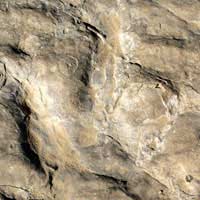
Laetoli in Eastern Africa’s Tanzania, is home to one of the most famous archaeological sites. There is no gold, no treasure, no skeletal remains, not even one stone tool or a single potsherd. The site has become famous for the footprints left behind by people way back in antiquity.
The distinctly human footprints have been fossilised in the clay, buried by sands and soils, and only discovered in 1978 by Mary Leakey.
Looking for the Link
Well-known anthropologist and archaeologist, Mary Leakey, began excavating the Laetoli site in 1974. It was her belief that early humans inhabited this region and it was a likely location that might yield valuable human remains. The fossil record is woefully incomplete for the theoretical period when archaic Homo sapiens transitioned to an upright posture. Leakey was searching for evidence of such evolution and strongly believed it would be found in Tanzania, as this was generally thought to be the primary source of African man.
Fossilised Human Footprints
After almost five years of excavations Mary discovered three sets of well-fossilised footprint trails, preserved in the baked Tanzanian ground, which she thought were made by two adults and one child. In total there were as many as 70 individual footprints in two clean parallel lines about 30 metres long. They are alleged to be the oldest footprints ever discovered.
How They Were Made
Some time in antiquity a volcanic ash layer was deposited over the Laetoli region. The human inhabitants of the area walked across this thick soft ash leaving a trail of deep footprints as evidence of their occupation. The ash hardened then filled with wind blown sand. The intense heat of the African sun oven-baked the prints as if in a kiln and fossilised the impressions.
Preserving the Prints
The excavation site was reburied in 1979 to preserve the footprints. However, it was not long before vegetation began to grow and many archival researchers were concerned that the roots of the plants might encroach into the buried footprints and damage them.
The Getty Conservation Institute of Tanzania reopened the site in 1996 and was pleased to find that the shallow rooted trees had not harmed the prints. The prints were photographed and survey teams made accurate contour maps. After all recording was completed on the site the footprints were buried once again, this time by careful successive layering of sand and soil.
Dinosaur Prints
The finest example of detailed dinosaur tracks is found in the Paluxy River bed in Texas, USA. Dr Don Patton, a consulting geoarchaeologist, began excavating this region in September 2000 although he was not the first to have discovered them.
As early as the late 1970’s, field investigator, Mike Turnage, detected the long trail of print holes, with his feet, as he walked in the rapidly flowing, deep water of the Paluxy River. Only a hot Texas drought caused the river to dry and the prints to be revealed.
The longest dinosaur trail contains 136 consecutive tracks, extending for over 130 metres. The continuous, uninterrupted length and the meticulously preserved detail of each print makes this one of the greatest displays of dinosaur tracks to be found anywhere in the world.
The uncovering and cleaning of the prints took a team about five weeks. The Metroplex Institute of Origin Science conducted site supervision.
Humans and Dinosaurs
The Turnage-Patton Trail of dinosaur tracks in Dinosaur Valley State Park are now notoriously famous. Less well known is the formation of fossilised tracks of humans and dinosaurs on the same strata material formed at the same time in history.
The footprint trail known as the Taylor Trail, after its discoverer, Stan Taylor, is also in the Paluxy River bed. Taylor began his excavations in 1969 and continued every season for three years. He discovered a very long dinosaur trail that travelled at 30 degrees across the riverbed. However, what was of startling importance was that running alongside the three-toed dinosaur prints was a trail of modern human footprints, in some cases even overlapping the dinosaur tracks.
Co-existing
The remarkable nature of this find was that both sets of prints were formed on the same bedding plane, which suggests that they must have been made relatively soon to one another and certainly before the mud bed dried.
In the 1930’s, Jim Ryals removed an entire fossil slab from the riverbed containing a clear, detailed left human footprint. He left the right print and other tracks untouched.
The evidence of co-habitation of dinosaurs and humans is alarming to closed-theory evolutionists but it is not a new assumption. Could St George’s slain dragon be a dinosaur? Many cultures, in particular the Chinese, strongly subscribe to ‘dragon’ dinosaurs in their recent past. The bible speaks of the two great dinosaurs, Leviathan and Behemoth.
Destroying the Evidence
The evidence that humans actually lived with dinosaurs was too disturbing for two evolutionary scientists who, after hearing Dr Patton at the 1989 science conference, immediately flew to Dallas, Texas, and the next day, using a crowbar, destroyed the remaining human footprints in the riverbed. However, their quest was undone when the Texas drought of 1999 revealed another, even more dramatic trail of human and dinosaur tracks together, the best archaeological artefacts yet to show that humans lived with the dinosaurs.